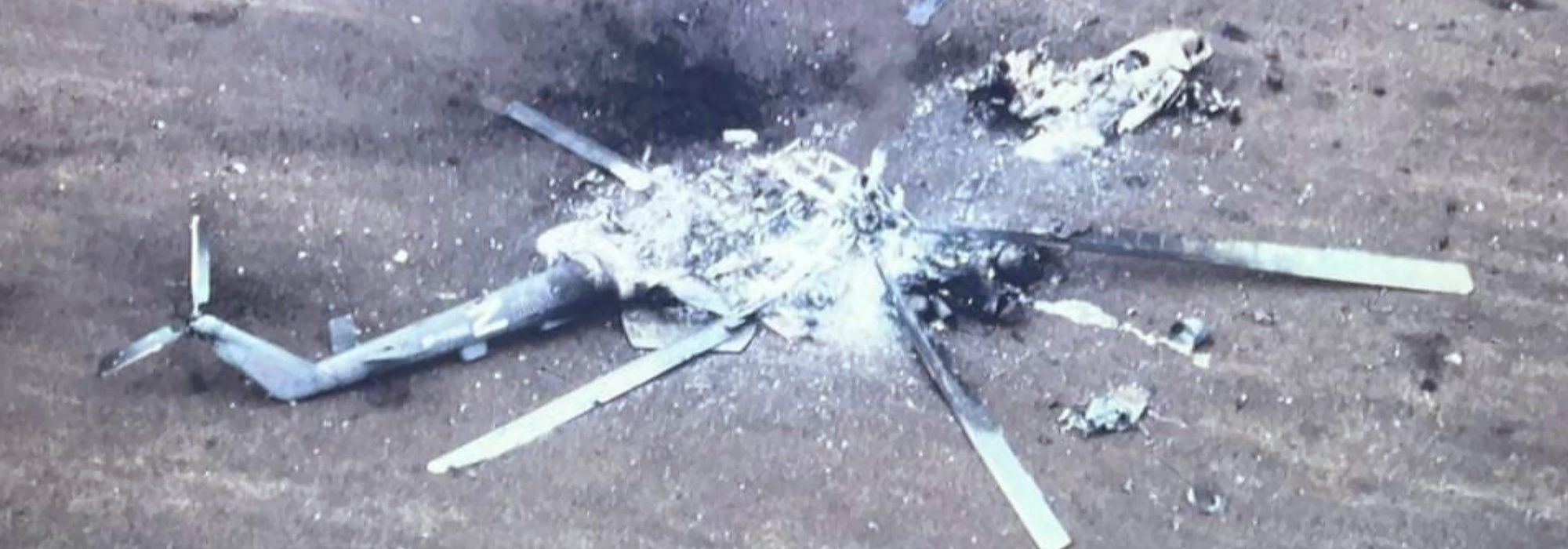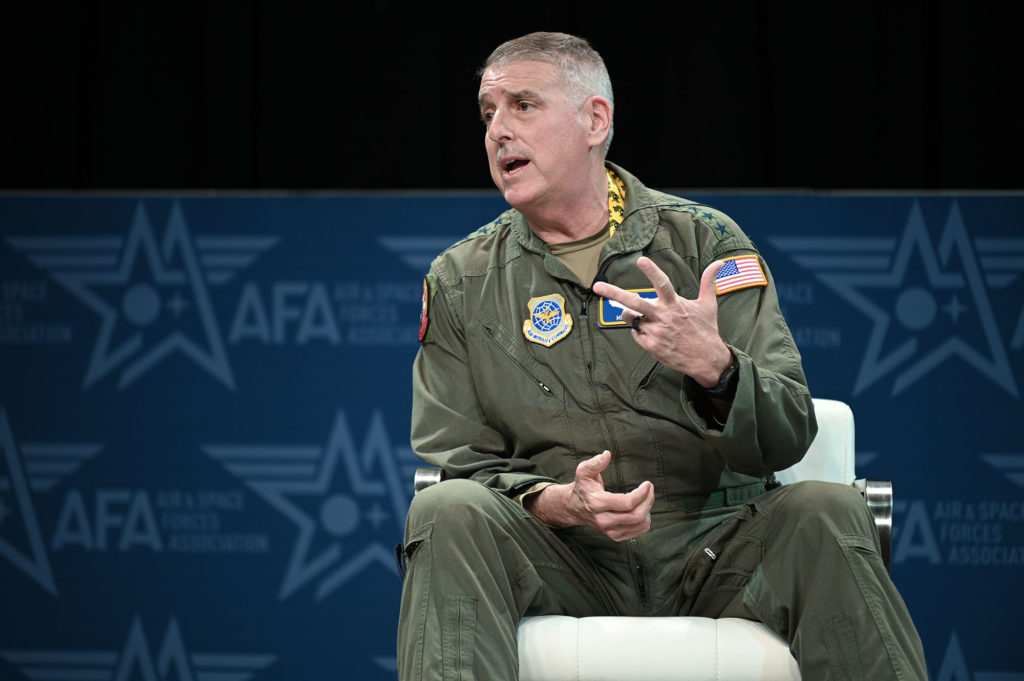Lack of Airpower in Ukraine Proves Value of Air Superiority
By Chris Gordon
R
ussia’s failure to assert air superiority in its invasion of Ukraine demonstrates exactly how vital that capability is to success in conflict, said Gen. James B. Hecker, the top U.S. Air Force commander in Europe, March 22.
“One of the things that we see is the lack of either side—whether it be the Russian or Ukrainians—[achieving] the ability to get air superiority,” Hecker said during an Aerospace Nation event with AFA’s Mitchell Institute for Aerospace Studies. “That has really changed this into a different fight that we haven’t seen in quite a while.”
If Russia had gained air superiority early in the conflict, Hecker suggested, Ukraine would have been finished off militarily long ago.
Instead, however, Ukraine’s air defenses and poor Russian tactics bought Ukraine time to generate international support and open up a flow of aid, including arms, access to technology, and humanitarian supplies. Since 2022, the U.S. alone has pledged over $40 billion in arms support for Ukraine, an amount approaching what the entire U.S. Space Force spent in that same time frame.
Air Force Gen. Jacqueline D. Van Ovost, head of U.S. Transportation Command, recently said her command had made 1,000 airlift sorties and delivered an additional 65 shiploads of aid for land-locked Ukraine, with deliveries going through neighboring countries and then reaching Ukraine mostly by rail and truck.
Hecker said the West could not have managed that had Russia won control of the skies.
“Let’s say the Russians had air superiority,” he said. “If they were able to, all that equipment … wouldn’t have gotten there because there would have been Russian close air support sitting over those lines of communication coming in from the other countries. And as soon as it got into Ukraine, it would have been demolished.”
Conversely, Ukraine’s lack of airpower resources has kept it from overcoming Russian air defenses; had it been able to do so, Ukraine could have blunted Russia’s invasion in its initial phases.
Now, a brutal war of attrition has set in, with both sides suffering tens of thousands of casualties, as U.S.-made 155 mm howitzers and precision HIMARS rockets pound away for Ukraine and Russia’s Iranian-made one-way attack drones and stand-off cruise missiles pummel Ukraine from the air.
“From the Russian side, they don’t care if you hit hospitals, they don’t care if you hit schools, they don’t care if you hit malls,” Hecker said. The result is “massive destruction, massive casualties—just something that we’re not used to.”
As commander of U.S. Air Forces in Europe (USAFE) and NATO Allied Air Command, Hecker is the airpower point person for 30 nations aligned in opposition to Russia’s invasion, but united in trying to stay out of the conflict. Gradually, however, NATO activity has expanded, from Air Policing missions at the start, to exercises that approximate what NATO would do if Russia expanded its war to the West, to routine intelligence missions, such as the one in which an unarmed MQ-9 Reaper drone was felled after a Russian Su-27 Flanker clipped its propeller after first trying to dump fuel on it.
“What we’re looking at and concentrating on at USAFE is what can we do to ensure that we get air superiority should we have to invoke Article V [NATO’s mutual self-defense clause], and then what can we do to make sure that our enemy doesn’t get air superiority,” Hecker said.
“The number one priority to make sure that we’re able to get air superiority is to make sure that we can do the counter-IADS mission,” Hecker said, referring to Russia’s integrated air defense systems. “What we’ve seen on both sides—both Russia and Ukraine—is their integrated air and missile defenses are working pretty well, to the point where they’re shooting down the other’s aircraft And the aircraft aren’t as visible as they should be if they’d concentrated more on air superiority.”
Ukraine has lost around 60 aircraft and Russia has lost over 70 aircraft, Hecker revealed at the AFA Warfare Symposium in early March.
NATO, in turn, must bolster its own air defenses, Hecker said. The Air Force must also increase information sharing among allies and focus on Agile Combat Employment (ACE) to disperse its targets, he added.
In Hecker’s role as commander of USAFE, he is helping the U.S. provide Ukraine with information to assist its targeting. The U.S. has also been providing hardware, including AGM-88 HARM anti-radiation missiles to attack Russian surface-to-air missile sites, and 500-pound JDAM extended-range guided bombs.
The Biden administration has so far declined to provide long-range ATACMS missiles for HIMARS, has prohibited U.S.-origin weapons from being used against Russian territory, and has held fast against delivering fighter aircraft, such as F-16s. Ukraine’s air force will be aided, however, by the donation of 17 Soviet-era MiG-29s from eastern European NATO allies. But with Russian air defenses across the border in Russia and in neighboring Belarus, seemingly out of range of Ukraine’s ability to attack, that will pose additional challenges for the MiGs,.
Still, Hecker said, capacity is important. “Any more quantity is going to help [Ukraine],” he stated. “This will allow them to come at different axes, which will complicate the problem Russia has.”
Doing that is critical to blocking Russia from gaining the upper hand in the ongoing slugfest. “In the short term,” Hecker said, “we just need to make sure that Russia does not get air superiority.”
Minihan: Mobility Guardian 23 Will Test Airmen in New Ways
By David Roza
AURORA, Colo.
Air Mobility Command aims to find out how Airmen manage the combined challenges of distance, open ocean, and joint-force integration at a major Pacific exercise this summer.
Operation Mobility Guardian is usually a domestic event, but this year AMC is amping up the challenges, said Gen. Mike A. Minihan, AMC commander, during the AFA Warfare Symposium. “We moved that into the theater that matters,” he said. “We are going to understand intimately what the tyranny of distance is and what the tyranny of water is.”
Mobility Guardian is USAF’s largest full-spectrum annual mobility readiness exercise, and typically tests the command’s ability to refuel aircraft, transport equipment, and practice aeromedical evacuations and the like. Plans for Mobility Guardian 2023 took shape over five days of planning sessions in February, where some180 leaders representing the Air Force, Army, Navy, Marine Corps, the U.S. Department of State, and seven allied nations came together. The event itself will take place under the authority of U.S. Indo-Pacific Command this summer.
For Minihan, the exercise is a chance to find out whether the changes he’s pushed since taking over the command in October 2021 have borne fruit. He sees four crucial areas in which mobility troops must come out ahead to be ready to fight and win against China—command and control, navigation, tempo, and “maneuver under fire,” which Minihan defines as being able to execute maintenance, logistics, and fueling to keep the joint force operational.
“Can we operate at the tempo required to win? Can we operate at the tempo greater than our potential adversaries?” Minihan asked March 7. “You cannot have integrated operations if you do not have integrated planning in advance.”
Mobility Guardian 2023 will put that integration to the test.
“As the joint force maneuvers, we have to service everybody,” Minihan said. “We are going to have a chance to do that in the theater: We are going to have a chance to work with all these entities, and we’re going to test the planning integration to see if that really turns into operational integration in the theater.”
It will not go perfectly, he pointed out, but it will expose the gaps in capability and knowledge that must be bridged in the future.
“We’ll learn something,” Minihan said. “Some things won’t go perfectly, and we’ll go back … and close gaps as quick as we can.”


